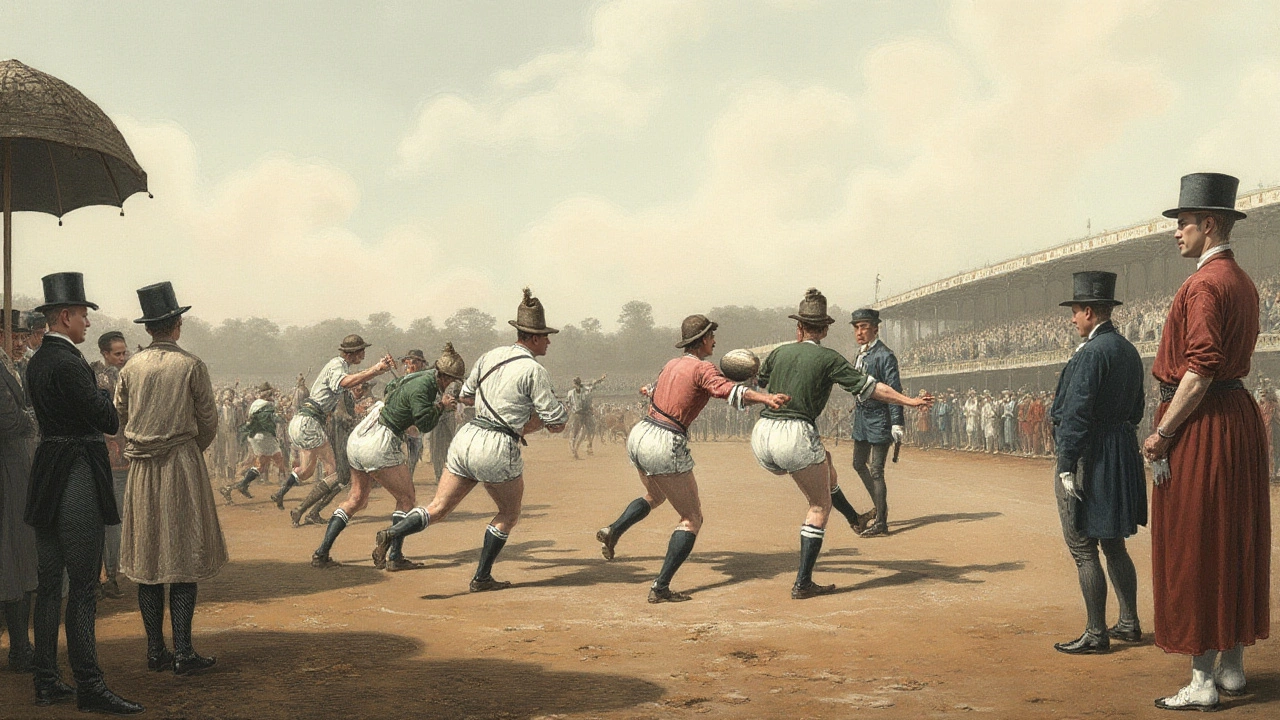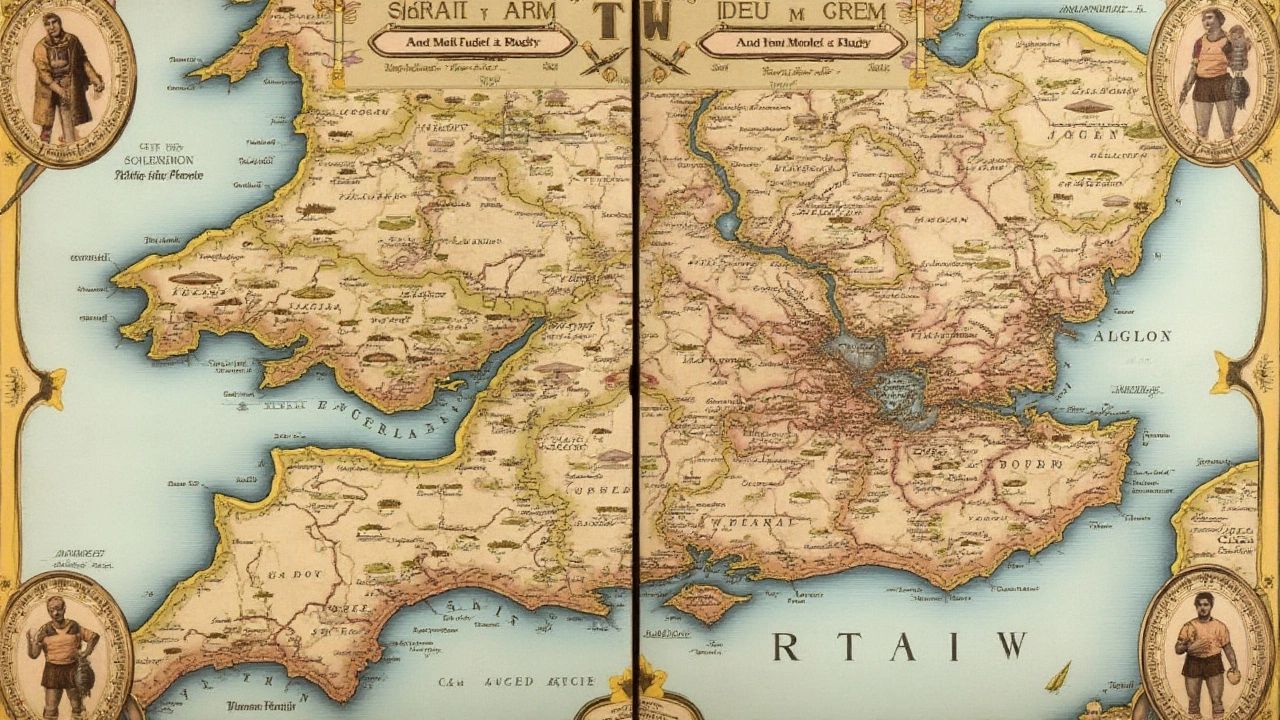Rugby is a sport that thrills with its power, strategy, and rich history. The game is often linked to an almost mythical tale involving a young Englishman, William Webb Ellis, who in 1823 supposedly defied the norms of soccer by picking up the ball and running with it. But like many legends, the story of rugby's invention is both intriguing and somewhat embellished, with threads of truth woven into much legend.
Delving deeper, we find that rugby’s origins are closely tied to the traditions and competitive spirit fostered at Rugby School in England, where various forms of football were played for years. It's a tale that speaks of evolution, transformation, and global spread as rugby moved beyond schoolyards to become a structured sport with international fixtures captivating millions.
In this exploration, we’ll uncover the milestones and remarkable personalities that shaped rugby into what it is today. Grab your virtual jersey and join the historical scrum as we dive into the inception and growth of this beloved sport.
- The Legend of William Webb Ellis
- The Role of Rugby School
- Evolution into Modern Rugby
- Rugby’s International Expansion
The Legend of William Webb Ellis
The tale of William Webb Ellis is one that delights and perplexes rugby enthusiasts around the globe. At its core, it's the story of a young boy who took an impromptu action that allegedly gave birth to a new sport. In November of 1823, at Rugby School in Warwickshire, England, Webb Ellis is said to have brazenly caught a soccer ball and, breaking all existing rules, sprinted toward the goal. This audacious deviation from the norm is romanticized as the spark that ignited the exciting game of rugby. Yet, historians have since scrutinized this account, calling into question its authenticity. The story first emerged in 1876, over five decades after the purported event, thanks to a former student’s remembrance rather than factual records.
The lack of contemporaneous evidence lends an air of mystery and legend to Webb Ellis's role, and many academics are quick to emphasize it's more myth than historical fact. Nevertheless, his name has become synonymous with rugby, immortalized in the sport’s greatest prize – the Webb Ellis Cup, awarded to the winners of the Rugby World Cup. Constant debates ensue over Webb Ellis's genuine contribution to the rugby invention, yet their persistence only magnifies the legend; perhaps it is this very blend of mystery and verifiable history contributing to rugby's lasting allure.
"In history, legends have a way of getting exaggerated, but they shape the very essence of our culture," remarks historian Thomas Hughes, highlighting the enigmatic influence of Webb Ellis.
It's important in our understanding of rugby history to also recognize the dynamic sporting scene of England in the early 19th century. Rugby School at the time encouraged a variety of rough-and-tumble ball games, each with its own local rules and customs. These grassroots games bore more resemblance to a form of medieval football, involving handling the ball in ways contemporaneous soccer would find shocking. As observers continued to document sporting traditions in schools, the myth of Webb Ellis was solidifying into a foundational narrative. There's a certain romantic appeal in the chaos and creativity of youth that Webb Ellis represents—a spirited breakaway from the norm, which, for many, epitomizes the sport itself.

The Role of Rugby School
Rugby School in Warwickshire, England, isn't just a place; it's a keystone in the annals of sporting history, especially when it comes to the origins of rugby. Founded in 1567, the institution wasn't only an educational establishment but a crucible of innovation and youthful energy that would give birth to a sport known by millions today. In the early 19th century, Rugby School played a pivotal role in the development of early football games. It was the unique set of rules developed by students that set the stage for rugby as a distinct sport.
The most famous anecdote involving the invention of rugby often highlights William Webb Ellis, a student at the school who is said to have picked up the ball and run with it during a soccer game in 1823. While this tale is embroidered with plenty of romanticism and lacks substantial evidence, it underscores a spirit of innovation that had become synonymous with Rugby School. The institution encouraged not just physical prowess but creativity and leadership that translated into different sporting codes.
Rugby School's influence didn't remain confined within its stone walls. In 1845, the students themselves penned the first written rules of the game. This was a revolutionary step, birthing what we now acknowledge as modern rugby. The Rules of Rugby School defined many aspects that became core facets of rugby—the distinctive oval ball, the tackling method, and the scoring system. These were meticulously documented, spreading like wildfire to other schools and universities like Cambridge and Oxford, where they were eagerly adopted. According to a letter from Thomas Arnold, a former headmaster, the school harnessed not only a place of learning but also a nursery of leadership and teamwork.
The palpable enthusiasm for the game led the way to its evolution, fostering inter-school competitions that became increasingly popular. This was a time of synergy, where each team brought unique styles, while adhering to overarching rules that established cohesion. It's not surprising, then, that by the latter half of the 19th century, rugby transcended educational settings, paving the way for the formation of club teams and national organizations. Rugby School was, therefore, more than a silent witness to this evolution; it was an active laboratory where ideas were tested and deployed to create a burgeoning new sport.
Rugby's lore is kept alive by more than just school records and oral traditions. Visit the hallowed grounds of Rugby School today, and one might stumble upon a plaque dedicated to Webb Ellis, celebrating the schoolboy's audacious move as the spark that ignited a global phenomenon. Rugby School's continuing commitment to the sport is evident in its curriculum and gatherings, paying homage to its own history while nurturing the next generation of players who carry the spirit of the school's legacy—roaring, tackling, and thriving in the world arena.

Evolution into Modern Rugby
The journey of rugby from its early beginnings at Rugby School to the globally recognized sport it is today is a tale of evolution, adaptation, and refinement. The story began with the codification of the rules, a necessary step to recreate consistency among the various forms of the game played across schools in England. These were documented for the first time in 1845 by the pupils of Rugby School to capture the essential rules, setting the foundation for the game's organized development. It was here that rugby history began to take shape, and these guidelines formed the core of what would become modern rugby.
As rugby spread throughout the British Empire, it sympathized with the need for a more formal structure. This was achieved with the formation of the Rugby Football Union (RFU) in 1871, marking another pivotal development in the evolution of the sport. The RFU's responsibility was to oversee the implementation of standardized rules and ensure fair play, solidifying the governance necessary for growth. Now equipped with a centralized body to manage disputes and oversee the game's direction, rugby cemented its place in the hearts of its participants and viewers alike.
Rugby grew in popularity, leading to its split in 1895 into two distinct versions: rugby union and rugby league. The division arose mainly due to disagreements over player compensation, known as the 'Rugby Schism,' emblematic of a broader social struggle. As a result, rugby league adopted professionalism while rugby union maintained its amateur status until 1995, when it finally embraced professionalism. This bifurcation didn’t thwart the sport’s appeal; rather, it diversified the audience and provided options for enthusiasts, ensuring rugby’s continual growth in both formats across continents.
One interesting aspect of rugby's evolution is how it was influenced and shaped by different cultures and countries, each adding unique flavors and competitive rivalries. Rugby’s international debut occurred in 1881, when the first match was held between England and Ireland. From there, rugby bloomed internationally, creating iconic rivalries such as the All Blacks of New Zealand against South Africa’s Springboks. Their encounters became legendary battles on the rugby field, showcasing not only the physicality but also the unity and patriotism bound within rugby origins.
"Rugby is a good occasion for keeping thirty bullies far from the center of the city." - Oscar Wilde
The sport's administration continued evolving as it gained momentum on a global stage. 1987 marked the first Rugby World Cup, hosted by Australia and New Zealand, which further cemented rugby's prestige on the international scene. The World Cup showcased top-tier talents and generated global interest, leading to the establishment of rugby fixtures as a staple in sports culture. Since then, it has become one of the most-watched sporting events worldwide, influencing generations and inspiring new players.
In the modern era, rugby has embraced technology and media to enhance viewer experience while maintaining the game's core values. Interactive fan engagements, data analytics, and advanced training regimes have all contributed to advancing the sport without compromising its roots. Rugby's governing bodies continue to innovate, promoting inclusivity and ensuring rugby is accessible to all. The evolution of rugby into a modern sport is a testament to its adaptability, community, and enduring global legacy.

Rugby’s International Expansion
As the nineteenth century unfolded, rugby began to transcend the familiar English countryside where it had taken its formative steps. The spread of the game to other parts of the globe was fueled by the British Empire's expansive reach, a dominion where the sun famously never set. Rugby became more than just a sport; it was a cultural export, carried by soldiers, sailors, and settlers to diverse lands. Across continents, from Australia to South Africa, the rules of rugby, honed initially at Rugby School, were being embraced and adapted. Of particular note, New Zealand and South Africa emerged as powerhouses, nations where rugby wasn’t just a game but a part of the national fabric.
The formalization of international competitions further anchored rugby’s global presence. The first international match in 1871 saw England take on Scotland, marking the beginning of a tradition that would evolve into the Six Nations Championship and other prestigious tournaments. This was a significant moment for rugby history, as it set the stage for the thrill of international rivalry that rugby fans cherish today. During these matches, the fervor of national pride was palpable, and the skill and strategy on display captivated audiences far beyond the pitch.
By the late 19th and early 20th centuries, rugby clubs and unions were sprouting up across Europe, the Americas, and Oceania. The International Rugby Board, now known as World Rugby, was established in 1886 to oversee international competition. A key driver in this expansion was the *rugby union*, a governing body that helped standardize rules, allowing for a smoother transition and acceptance of the game across different cultures. The role of dedicated individuals and pioneers cannot be understated in this process, as they acted as ambassadors for the sport in new territories.
The 20th century's technological advances, including faster travel and global communication, further accelerated rugby's international expansion. Broadcasting brought the dynamic spectacle of rugby into living rooms worldwide, which significantly boosted its popularity and accessibility. This period also saw the birth of the Rugby World Cup in 1987, a tournament that now stands as one of the most celebrated and competitive events in the sporting world. Drawing teams from various countries, it showcases the culmination of a sport that started in a small English town and transformed into a worldwide phenomenon.
The Global Sevens Concept
Another important aspect of rugby's international spread is the Rugby Sevens format, which was developed in the Scottish Borders in 1883. This format, featuring seven players on each side and shorter matches, gained traction for its fast-paced and entertaining style. It wasn't long before Sevens tournaments became major fixtures globally, reaching audiences and players who were looking for a different variant of the classic game. The inclusion of Rugby Sevens in the Olympics in 2016 marked another pivotal milestone. It propelled the game to unprecedented levels of visibility and acceptance across numerous countries that were previously unfamiliar with rugby. The faster and more open play drew in not just seasoned rugby enthusiasts but also new fans curious about the sport's multifaceted appeal.
The heartfelt words of Nelson Mandela highlighted rugby's profound impact: "Sport has the power to change the world. It has the power to inspire. It has the power to unite people in a way that little else does." This sentiment holds particularly true for rugby, which continues to challenge and bridge cross-cultural boundaries.





